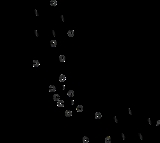
FAD
Overview
Biochemistry
Biochemistry, sometimes called biological chemistry, is the study of chemical processes in living organisms, including, but not limited to, living matter. Biochemistry governs all living organisms and living processes...
, flavin adenine dinucleotide (FAD) is a redox
Redox
Redox reactions describe all chemical reactions in which atoms have their oxidation state changed....
cofactor
Cofactor (biochemistry)
A cofactor is a non-protein chemical compound that is bound to a protein and is required for the protein's biological activity. These proteins are commonly enzymes, and cofactors can be considered "helper molecules" that assist in biochemical transformations....
involved in several important reactions in metabolism
Metabolism
Metabolism is the set of chemical reactions that happen in the cells of living organisms to sustain life. These processes allow organisms to grow and reproduce, maintain their structures, and respond to their environments. Metabolism is usually divided into two categories...
. FAD can exist in two different redox states, which it converts between by accepting or donating electrons. The molecule consists of a riboflavin
Riboflavin
Riboflavin, also known as vitamin B2 or additive E101, is an easily absorbed micronutrient with a key role in maintaining health in humans and animals. It is the central component of the cofactors FAD and FMN, and is therefore required by all flavoproteins. As such, vitamin B2 is required for a...
moiety (vitamin B2) bound to the phosphate group of an ADP
Adenosine diphosphate
Adenosine diphosphate, abbreviated ADP, is a nucleoside diphosphate. It is an ester of pyrophosphoric acid with the nucleoside adenosine. ADP consists of the pyrophosphate group, the pentose sugar ribose, and the nucleobase adenine....
molecule. The flavin group is bound to ribitol
Ribitol
Ribitol or adonitol is a crystalline pentose alcohol formed by the reduction of ribose. It occurs naturally in the plant Adonis vernalis, as well as in the cell walls of Gram positive bacteria . It also contributes to the chemical structure of riboflavin.-External links:**...
, a sugar alcohol, by a carbon-nitrogen bond, not a glycosidic bond
Glycosidic bond
In chemistry, a glycosidic bond is a type of covalent bond that joins a carbohydrate molecule to another group, which may or may not be another carbohydrate....
.
Unanswered Questions

